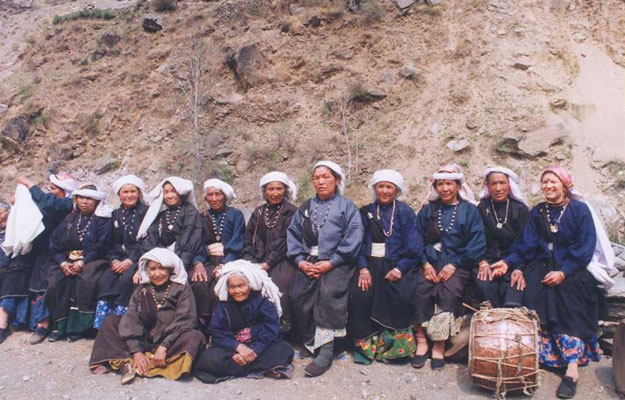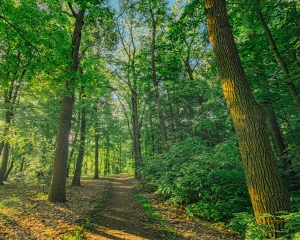
Ceti, English Wikipedia, CC BY-SA 3.0
The Chipko Movement: An Indian Tree-Hugging Protest that Revolutionized Environmentalism
By Gayil Nalls
Sign up for our monthly newsletter!
I n 1974, in a Himalayan village in India, a group of women took a stand that would forever change the landscape of environmental activism. They wrapped their arms around trees, placing their bodies in front of gun and axe-wielding men, guarding the trees through the night and forcing the aggressive loggers to leave. India had never before witnessed women participating in a movement of this scale. Their courageous, non-violent act of environmentalism not only impacted the conservation of natural resources in India but also resonated with activists worldwide, inspiring figures like Julia Hill, who lived in a 1,000-year-old California redwood from 1997-1999 to save it.
The Chipko Movement stands as one of the most significant environmental campaigns in history. Thirty years after the first all-woman Chipko action in Reni village in 1974, these women reassembled for a commemorative photograph, underscoring the lasting impact of their efforts. Born out of a dire need to protect forests from rampant deforestation, the movement became a symbol of grassroots activism and ecological consciousness. The term “Chipko,” meaning “to hug” in Hindi, reflects the movement’s core tactic: villagers, primarily women, physically embraced trees to prevent them from being felled by loggers.
The movement took root in the small village of Reni, in the Garhwal region of Uttar Pradesh (now Uttarakhand), when this group of local women, led by Gaura Devi, organized to protect their forests. The area had long suffered from deforestation by contractors who ignored the ecological and economic importance of the forests to the local communities. In response to government-sanctioned logging, the women of Reni, armed with nothing but their determination and physical presence, wrapped their arms around the trees, forcing the loggers to retreat.
Activists such as Sunderlal Bahuguna, Chandi Prasad Bhatt, and Gaura Devi spearheaded the Chipko Movement. Their nonviolent resistance drew inspiration from Mahatma Gandhi’s philosophy of Satyagraha. The movement was unique in its widespread involvement of women, who were deeply connected to the forests for their daily needs, such as food, fuel, fodder, and water. This brought respect to the movement and underscored the role of women in environmental stewardship, challenging traditional gender roles.
The Chipko Movement garnered significant attention, both nationally and internationally. It led to a series of reforms in India’s forestry policies, including the 1980 Forest Conservation Act, which imposed strict regulations on the use of forest land for non-forest purposes. The movement also inspired similar ecological protests across India, highlighting the intersection of environmental and social justice issues.
The legacy of the Chipko Movement continues to resonate in modern environmental discourse, particularly in the context of climate change. The movement’s emphasis on community-led conservation, sustainable resource management, and biodiversity protection is more relevant than ever. In an era of escalating environmental crises, the principles of the Chipko Movement offer valuable lessons in resilience, grassroots activism, and the importance of preserving natural ecosystems.
The Chipko Movement remains a powerful reminder of the impact collective action can have on environmental protection. Its success in halting deforestation and influencing policy changes demonstrates the potential of local communities to effect meaningful change. As the world grapples with the challenges of climate change, the Chipko Movement serves as an enduring symbol of hope and resistance, inspiring new generations to continue the fight for environmental justice.
Gayil Nalls, Ph.D., is the creator of World Sensorium and founder of the World Sensorium/Conservancy.
References
Mundoli, Seema. How tree-hugging protests transformed Indian environmentalism. Nature Vol. 6727, 28 March 2024, 730-732.
Plantings
Issue 40 – October 2024
Also in this issue:

Microbial Aromas Might Save Crops from Drought
By Ruth Schmidt

Can Trees Heal You?
By Catlin Chandler

The Art of The Brew: Brewing Tradition and Cultural Memory
By Gayil Nalls

How to Stop Being a Throwaway Culture: A Path Towards Sustainability
By WS/C Staff

The Allure of Goth Gardens: A Symphony of Darkness and Beauty
By Gayil Nalls

Eat More Plants Recipes:
Spinach Pasta
By John Steele

As Ireland transitions from the rich, smoky scent of peat-burning to a more sustainable future, its olfactory heritage is evolving. What will become the next iconic aromatic symbol of Ireland?
Click to watch the documentary trailer.

